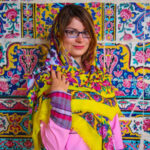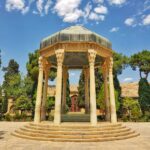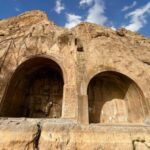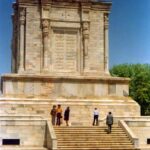The Land of Elam Civilization


known as Avaz or Avaja to Achaemenians (6th century BC), this ancient city is now the center of the oil-rich Khuzestan province. It was a seat bishopric in 4 AD and after the conquest of Arabs (12th & 13th century AD) became a major trading center. It was severely attacked and turned into a center of resistance during the war with Iraq. These days, Ahwaz is only a convenient place to start touring places like Suss, Chogha Zanbil, Dezful, and Sustar.
• Susa (Shush)
One of the oldest cities in the world, dating back to the 4th millennium BC. It was in 1852 when the city was identified as the classical Susa and the Biblical Shushan where Darius I made his winter palace, but now, apart from a few columns, nothing has remained from the original palace. Nearly all the artifacts and architectural remains from this site have been transferred to foreign museums by archeologists.
• Choga Zanbil
45 km southeast of Susa. Choga Zanbil was accidentally discovered during an aerial survey. It is the best surviving example of Elamite architecture in Iran and Mesopotamia dating back to 10 3rd millennium BC. Out of the five-story ziggurat, only three stories remain, it also holds 3 palaces, 11 temples, and a reservoir.
The Home of Sufi Leader
The history of Ardabil goes back to the 5th century AD. Known as the capital of Azerbaijan province since the 10thcentury, it was later destroyed by the invading Mongols in 1220 AD. Ardabil is the birthplace of “Sheikh Safi, the founder of Sufi” order (14 AD). Sheikh Safi’s Mausoleum complex in Ardebil comprises a number of architecturally and historically valuable structures.
Sabalan & Sarein: Sabalan volcano, only 25 km west of Ardabil, is the country’s second highest peak (4,860m). The natural beauty of the slopes and the dreamlike panoramic view from the mountaintop, attract many climbers to the region. Mountain’s volcanic hot and cold water springs attract millions of people to Sarein, the center of spas.
Tehran, the capital city



Iran’s capital, Tehran is one of the biggest and most significant metropolis in the world. It is placed in a large area and embraces unique attractions, landscapes, and historical attractions.
Tehran was originally a small village near the city of Ray, the ancient capital of Iran. Tehran’s prosperous years they started in the 18th century when the first Qajar king made Tehran his capital. Most of the historical buildings of Tehran, therefore, date back to that era. The geographical situation of Tehran has created enjoyable summer and winter resorts for the 12 million inhabitants of this busy mega-city. Lifestyle in Tehran varies according to the interests of different social groups; much the same as in other major cities of the country. Entertaining family and friends at home is still extremely popular, and foreign visitors are particularly welcomed if they find their way into such gatherings. Alternatively, some prefer to mingle in the artistic world of musicians, painters, and sculptors in galleries, cafes, theatres, and concert halls. Others favor a more active lifestyle and go skiing, trekking, climbing, water skiing, and gliding in the nearby resorts. Some, being more traditionally inclined, choose to pass their time sipping tea, smoking Nargileh, and biting into delicious local bread and juicy kebabs by the riverside cafes. At the same time, more relaxed people take pleasure in fishing for trout in the Jajrood and Karaj rivers.
• Golestan Palace
The former Qajar royal residence and ceremonial palaces of the last Iranian dynasty which is a mixture of ancient Persian and contemporary European architectural styles.
• The National Museum (Iran-e Bastan)
Prehistoric, Achaemenid, and Sasanian finds as well as exhibits from the Islamic era.
• National Jewels Museum (previously known as the Crown Jewels)
Among its priceless treasures lie Darya-ye Nur (Sea of Light) the world’s largest pink diamond (182 carats), and The Peacock Throne (inlaid with 26,000 gems).
• Abgineh Museum (Glassware & Ceramics)
The museum is in the heart of Tehran, surrounded by a 7,000 sq. garden. Works of enamel, crystal, glass, ceramics, and lapis lazuli are among the exhibits.
• Iran’s Carpet Museum
It covers an area of nearly 4,000 square meters representing a collection of the noblest and invaluable hand-woven carpets allowing you to witness the world’s top art treasures!
• Cultural Complex of Azadi Tower
The outstanding Azadi (freedom) monument, which became the symbol of Tehran, was built in 1971 to commemorate the 2,500 years of the Iranian Empire. Finds from prehistoric and Islamic periods are displayed on 3 floors in this inverted Y-shaped edifice.
• The Grand Bazaar
Although relatively new, it is one of the biggest bazaars in the East with around 10km of covered arches, alleys, and yards.
• Rey
A small bustling city southeast of Tehran, Rey’s history goes back to 5,000 BC when it was an important and rather large city. It continued to live up to this fame until 1,200 AD when it was destroyed by the Mongols. Rey is now a holy city and a center of pilgrimage. An interesting place to visit around Rey is Cheshmeh Ali, a water spring where, during the summer, people wash their carpets and spread them on surrounding rocks to be dried, thus creating colorful and unforgettable scenery.
Skiing

Shopping
Isfahan, the image of the world
Isfahan is one of the most beautiful cities in the Islamic world, stuffed with mosques, museums and palaces, and thousands of craft workshops.
At the foot of the Zagros Mountains, in central Tran, lies a city over 2,500 years old, with a turbulent, yet glorious past: Isfahan. Iranians still use the 16th century saying that it is “half the world”. The height of Isfahan’s glory was during the reign of Shah Abbas (1598 AD) when as the Capital, it housed magnificent palaces, mosques, avenues, and bridges. It was during Shah Abbas’ reign that Armenians were settled in Julfa to be safe from the atrocities of the Turks. The Shah gave them special privileges and guaranteed them the freedom to practice their way of life. Isfahan’s fine architecture and delicate artifacts symbolize Islamic Persia and are part of the world’s artistic heritage. One can spend weeks exploring the numerous and fascinating monuments: “Chehel Sotun”, “Hasht Behesht” and “Ali Qapu” palaces, “Imam Square” (twice as large as Moscow’s Red Square, surrounded by the finest mosques ever built in the Islamic world, where games of polo used to be played and royal processions were held), the “Qaisarieh Bazaar” (a maze of domed throughways, stretching for miles), “Friday”, “Sheikh Lotfollah” and “Imam” mosques, “Menar Jonban” (the shaking minarets) mausoleum and “Khajou” and Sio Seh Pol bridges over Zayandeh Rud river which runs through the town.
Shiraz, the city of peace & love







Shiraz is the city of poets, architects, and winemakers, and retains many of Iran’s pre-eminent mosques. In the nearby desert lie the well-preserved ruins of Persepolis, once the capital of the Persian Empire.
• Saadi’s mausoleum
Sa’dieh stands where his convent once was.
• Hafezieh
The present mausoleum of Hafez dates back to 1936, but the alabaster tombstone and four central columns of the colonnade date back from the Karim Khan Zand era.
• Monuments
The city holds some of the most captivating monuments in the country: mosques and shrines such as “Vakil Mosque”, “Shah-e Cheragh” and “Attiq Friday Mosque”, “Pars” and “Narenjestan” or the orangery museums, and gardens like “Eram” or Garden of Eden and Bagh-e Delgosha”. “Vakil & Saray-e Moshir” are its bazaars. However, the Armenian Church and the Church of St. Simon the Zealot also have beautiful Iranian architectural details.
• Naqsh-e Rostam
This so-called “Iranian Necropolis” is comparable to the “valley of Kings”. Four Persian Kings from the Achaemenid period (558-330 BC) are laid there: Artaxerxes I, Xerxes I, Darius the Great, and Darius.
• Pasargadae
Pasargadae is the first capital and the oldest remaining site of the Achaemenid Empire (558-330 BC). It was built by Cyrus the Great to honor his Victorious battle against the Medes. It has the remains of 3 palaces, a shrine, and the famous tomb of Cyrus.
• Persepolis
Persepolis was the “heart of the Persian Empire as well as the summer and ceremonial capital of the Achaemenians for about 200 years. The building of these magnificent royal structures started by Darius I (522-486 BC) and continued by the successive kings lasting altogether about 150 years. It consists of palaces, audience halls, treasury, storerooms, stables, etc. The main staircase leads to The Gate of All Nations. The most striking edifices are Apadana Palace and staircase; Darius winter palace “Tachara”, the central palace of “Tripylon”, the unfinished palace of Artaxerxes III “Hadish” and the splendid “Hall of 100 Columns”

A historic mud brick city





Yazd is a city where silk bazaars were renowned even in the days of Marco Polo and Qom is an important site of Shiite pilgrimage and scholarship.
A desert Oasis with a history going back to the years of Alexander, one thousand years before Islam. Yazd is located in a dry valley surrounded by the central Iranian desert. So dry that the water supply for its inhabitants used to be directed to the city by Qanats (underground aqueducts) from the neighboring Shir Kuh mountains. Zoroastrians have always lived in Yazd. The Atashkadeh (The Fire Temple) holding the sacred Zoroastrian flame – which is said to be burning since 470 AD and was brought here in 1940 – attracts the faithful pilgrims from around the world. The two Towers of Silence, dating back to the 17th century, bodies of the dead were left to decompose, are among the fascinating remains just 15km away from Yazd. The most striking feature of Yazd is its pre-Islamic architecture. To stay away from the scorching heat, living quarters were mostly built underground which cooled by the architectural wonder of the time, the Badgers (wind-catcher or wind-lowers). There are 12 bazaars in Yazd where shawls and other traditionally made textiles are found. Gold jewelry and all types of sweets and delicacies are also among the items to look for. Baghe-e Dowlat or the residence of the provincial governor is an attractive complex with traditional Persian architecture. Other places of interest include Amir Chakhmaq and Jame-e (Friday) mosques. Twelve Imam’s Shrine and Yazd Museum.
An oasis town on the edge of desert


One of the major cities of Isfahan Province with a 7,000-year history, Kashan is world-famous for its magnificent carpets, silk weaves, hand-painted tiles, and rosewater. Again it was during Shah Abbas I, that Kashan gained much importance. Kashan alleys are dotted with exquisite buildings with Persian Islamic designed architecture, Borujerdis Old House being a good example.
• Fin
With a thousand-year-old history, Fin is only 6 km southwest of Kashan. The town’s focal point is the famous Garden of Fin, a classical example of a Persian Garden—a Paradise which houses some attractive and important architectural monuments. The source of Sulaymaniyah Spring, which supplied the major part of Kashan’s water, is in the Garden of Fin. The spring also flows through the orchards of Fin village watching its famous figs and pomegranates.
• Abyaneh
70km southeast of Kashan, on the slopes of Karkas mountain, is the 1,300-year-old village of Abyaneh. The people of the village still wear their traditional costumes and the literate ones speak the ancient Parthian Pahlavi language. Houses are made of red clay and are built on the mountain slope, each house’s roof serves as the courtyard of the house above. The Zoroastrian population of the village mingles happily with the Muslim inhabitants, keeping to their customs and observing their traditions.
A city at the heart of the desert
In 1271 AD. Marco Polo remembered Kerman for its leatherworks, silk embroidery, and armors. It was much later that the town became world-famous for its carpet weavers and pistachio plantations.
Most of the original Kerman, built in the early 3rd century AD, was destroyed by an earthquake in the 18th century.
The surviving cultural and historical monuments include the 14th century Friday Mosque (Masjed-e Jam-e), the 12th-century Khajeh Atabeig Mausoleum, Jabalieh Dome (Gonbad-e Jabalieh) originally built in 2AD, the 17th century Ganj Ali Khan Bath, Vakil Bazaar, and the Anglican Church of St. Andrew.
• Bam Citadel (Arg-e Bam)
To the southeast of Kerman on the edge of the central Iranian desert, Dasht-e Kavir, lies the city of wonders, Bam. The city of the best silk weaves in the world, second only to that of China. A city with the mesmerizing sight of fruit orchards and palm groves, amid some of the driest and most arid land on earth…and the city of the most wonderful 2000-year-old citadel. Bam Citadel is the largest mud building in the world, molded in red clay and built on a rock mass, 200m wide and 300m long. It embraces a palace, a marketplace, military barracks, a bazaar, and a number of other private and public structures.
Desert excursion
The Pivot of Indigenous Kurds



The capital of Kermanshah province, is mostly populated by Kurds who speak their own language and observe their own traditions. The historic Kermanshah, which dates back to the 4th century AD, was situated close to the present town. Most of the places of interest are scattered outside Kermanshah and include: “Bisotun”, rock carvings, and inscriptions of Darius I, about 50 m above the ground on the Bisotun cliff. A series of relief and inscriptions at Tagh-e Bostan, the only Sassanian rock carvings outside Fars Province.
Dokkan-e Davoud (David’s Shop), a Median tomb from 7thcentury BC near the town of Sar-e Pol-e Zahab.
The Land of Azeris




Known as the birthplace of the Constitutional Revolution in Iran, the city’s origin goes back to distant antiquity, and perhaps even the pre-Sasanian era (224-651 AD). Although the city’s popularity and splendor never remained the same through the years, the peak of its glory and splendor was the 13th century.
Numerous historical monuments of Tabriz have been destroyed by natural and man-made disasters. What remains now, dates back to the Ilkhanids (13 &14th centuries), the Safavids (1502-1736), and Qajars (1795-1925).
Azerbaijan Museum, the 18th-century Bazaar and its caravansaries, mosques and schools; Blue Mosque is also known as “Mozafarieh”; Arg-e Alishah (Citadel of Tabriz) and Bagh-e Melli are among the places to visit in Tabriz.
An Armenian community has existed in Tabriz since the beginning of Christianity. During the centuries, they have erected six churches, one of which was mentioned in Marco Polo’s travelogue.
• Kandovan
50 km south of Tabriz and at the foothills of Sahand Mountain, there is a village whose inhabitants live in cone-shaped caves, naturally formed in the rocks of the mountain. It is said that the first people to have used these cones as living spaces were the soldiers of the Persian army around 800 years ago.
• Maragheh
A particularly articulated city in Azerbaijan, especially during the Mongols, 130km away from Tabriz, is Maragheh. Its famous observatory (active until about 700 years ago), university, and library – holding some 40,000 books – built between 1260-1272 AD were unique at the time.
The religious hub of Shiite



Mashad is the capital of Khorasan, the massive province of northeast Iran, which is larger than France and yet a fraction of its original size during the Persian Empire, when it stretched east to China, west to Rey, north to the Aral Sea, and south to Kerman. Towns such as Merv, Bukhara, and Samarkand now separated from Khorasan, were once parts of this province. For centuries, Mashad was an important trade center on the caravan route from India to Persia; and now, it is one of the holiest centers for the Shiite Muslims, who come for pilgrimage to the shrine of their 8th Imam. Some of the world’s best saffron and turquoise can be found in Mashad and its Grand Bazaar.
• Neishabur
The earliest recorded capital of Khorasan Province, with a turbulent history of being destroyed not only by earthquakes but also by barbarian invaders. Yet it has been the country’s epicenter for literary, artistic, and academic activities. It was the home of Omar Khayyam and Attar, the great Sufi poet and the famous Iranian painter, Kamal-ol-Molk.
• Tus
22 km northeast of Mashad, Tus is the home of the great Persian poet Ferdowsi who died in 1020 and now lies in a grand mausoleum built in 1968.
Neyshaboor Excursion
Tus Excursion
The Ancient capital of Median & Achaemenid Empires
Today’s Hamedan stands where once in the 7th and early 6th centuries BC, stood the Median capital, Hagmataneh. The city is built on the foot of Alvand Mountain and has been the center of civilization, culture, and science for many centuries. Cyrus the Great grew up there and it was home to Avicenna, the famous Iranian philosopher, and scientist. The Stone Lion was built by Alexander’s craftsmen (probably in commemoration of one of his generals) as well as the shrine of Esther-the queen or Susa and wife of Xerxes and her uncle Mordecai is among the interesting places to visit while in Hamedan. Other places of interest in Hamedan include Ganj Nameh, the oldest Achaemenian rock carving in the region, and Ali Sadr Cave, the only water cave in Iran.
